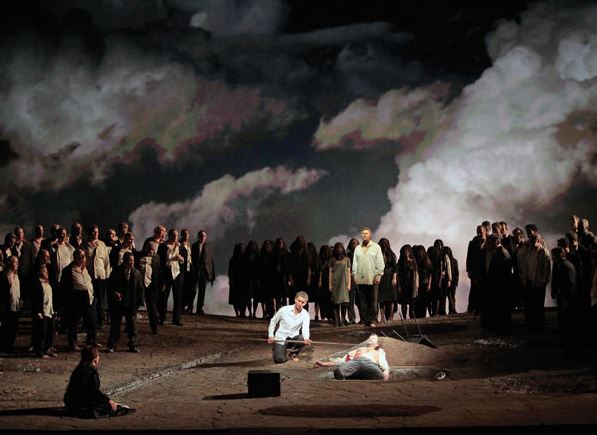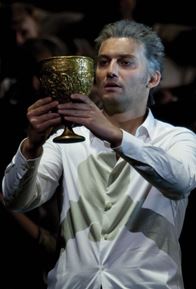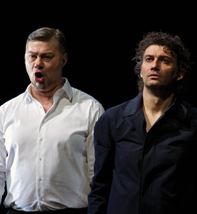|
|
|
|
|
|
|
Opera News, May 2013 |
| WILLIAM R. BRAUN |
|
|
|
Wagner: Parsifal, Metropolitan Opera, 15. Februar 2013 |
|
|
Parsifal-The Metropolitan Opera 2/15/13
|
|
Photos: Johan Elbers (1) and Beth Bergman (2,3) |
|
|
 The
Met gave the first performance of Parsifal outside of Bayreuth in 1903. In
the 110-year history of the work in the house, all of the productions have
been strictly representational of Wagner's stage directions. (Indeed, the
1991 Otto Schenk production was even more flat-footedly literal than its
1970 predecessor, directed by Nathaniel Merrill.) That changed on February
15, when a new production by François Girard, first seen in Lyon in 2012,
arrived at the house. Girard's production, like Wagner's libretto,
incorporates imagery from a variety of religious traditions. The Knights of
the Grail, who are onstage for all of Act I, are dressed, Mormon-missionary
style, in white shirts and black trousers. They sit in a circle on
uncomfortable community-center chairs. They pray separately from a group of
women, who are divided from the men by a gully bisecting the stage in
Michael Levine's arid, earthen set for Acts I and III. The gully runs with
blood, wound-like, for much of Act I, but during the Good Friday spell of
Act III it is almost "healed," and it runs with clear water. The congregants
sometimes perform Tai-chi-like gestures in synchronization. In line with
Wagner's idea that the temple of the Grail exists outside of time and place,
there is no scene change in either act, only a change from clouds to planets
in Peter Flaherty's video design and a change to "indoor" lighting. The
Met gave the first performance of Parsifal outside of Bayreuth in 1903. In
the 110-year history of the work in the house, all of the productions have
been strictly representational of Wagner's stage directions. (Indeed, the
1991 Otto Schenk production was even more flat-footedly literal than its
1970 predecessor, directed by Nathaniel Merrill.) That changed on February
15, when a new production by François Girard, first seen in Lyon in 2012,
arrived at the house. Girard's production, like Wagner's libretto,
incorporates imagery from a variety of religious traditions. The Knights of
the Grail, who are onstage for all of Act I, are dressed, Mormon-missionary
style, in white shirts and black trousers. They sit in a circle on
uncomfortable community-center chairs. They pray separately from a group of
women, who are divided from the men by a gully bisecting the stage in
Michael Levine's arid, earthen set for Acts I and III. The gully runs with
blood, wound-like, for much of Act I, but during the Good Friday spell of
Act III it is almost "healed," and it runs with clear water. The congregants
sometimes perform Tai-chi-like gestures in synchronization. In line with
Wagner's idea that the temple of the Grail exists outside of time and place,
there is no scene change in either act, only a change from clouds to planets
in Peter Flaherty's video design and a change to "indoor" lighting.
These acts accord well with Wagner's concerns about empathy and purity.
Directorial trouble arrives only in Act II, where Klingsor's domain is
revealed deep within the wound/gully. There is no engagement with the music
in this act, and an over-reliance on video design takes the place of
character development. The great Kundry–Parsifal confrontation, in which the
advantage changes a half-dozen times, passes without incident. During his
first solo, "Wehe! Was tat ich?" she ambles about upstage. When she sings
"Nun such' ich ihn," he returns the favor. Perhaps the superficial treatment
of Act II was meant to highlight the intensity of hard-won redemption in Act
III, in which Parsifal returns nearly dead from his quest, Amfortas
laboriously crawls into his own grave and Kundry is allowed to open the
Grail shrine but apparently dies from the exposure. Perhaps not.
Daniele Gatti produced a distinctive interpretation of the score from the
great Met Orchestra. It was a clear-textured yet luscious sound. When the
music depicted suffering — in Amfortas's monologue, in Parsifal's "Amfortas!
Die Wunde!" — the orchestral tone became, if anything, more beautiful. The
effect was extraordinary. The transitions in the duet of Act II, for example
from "Amfortas! Die Wunde!" into Kundry's "Gelobter Held!," provided
everything that was missing from the stage direction. Gatti's work was
obviously done in rehearsal; he elicited the enormous climax of Act I,
during the transformation music, with barely a stroke of his baton. But the
truly striking aspect of his performance was his partnership with René
Pape's sovereign Gurnemanz. Pape had sung the role at the Met before, but
with far less sympathetic conducting. Here, it seemed as if he and Gatti
could do anything together. Pape's performance had perhaps the widest
dynamic range of any sung in the house in memory. There was beautiful legato
in the scene with the dead swan, great tenderness in the Good Friday meadow
and unlimited power for "O wunden-wundervoller heilige Speer!" The Met has
had several fine Gurnemanzes in the last generation, but Pape's achievement
was historic.
Jonas Kaufmann sang with his usual flood of beautiful
tone in Act II, riding the crests of Gatti's waves, and he showed some real
acting skills in "Ja! Diese Stimme!," when Parsifal suddenly feels empathy.
Peter Mattei's Amfortas was admirably steady in wide-ranging intervals, even
as Gatti drew his music out to dangerous lengths. Likewise, Evgeny Nikitin
sang Klingsor with a fine voice and unusual accuracy of pitch in this role.
Unfortunately, he was inclined to speak too many of his words. Only Katarina
Dalayman's Kundry let the team down. Perhaps one in ten of her words was
intelligible, and many pitches were approximations. Girard made the
Flowermaidens into silly, spear-wielding warrior guards standing in a
stage-spanning pool of blood, but nonetheless Kiera Duffy, leading the first
battalion, made an auspicious Met debut.
 
|
|
|
|
|
|